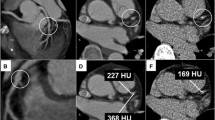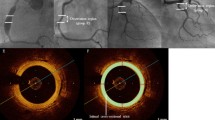Abstract
We wanted to clarify the relationships between the degree of acute coronary artery dilation caused by Kawasaki disease and subsequent late calcification. Electron beam computed tomography (EBCT) was used to study 79 patients who had previously undergone selective coronary angiograms less than 100 days after the onset of Kawasaki disease. The EBCT was performed using an Imatron C-150 with a 100-ms exposure time and consecutive images at 6-mm intervals. The interval from the onset of Kawasaki disease to EBCT ranged from 2 to 242 months (median, 103 months). The maximum diameters of the right coronary, the left anterior descending, and the left circumflex arteries, as well as the bifurcation of the left coronary artery were measured in the initial coronary angiograms. A total of 250 branches, including 53 left coronary arteries, were measured, and the relationship between the degree of the initial coronary artery dilation and subsequent calcification in the branches and left coronary artery was analyzed. The coronary arterial diameter of all branches that eventually calcified was 6 mm or greater. The incidence of calcification in branches measuring 6 mm or greater on the initial coronary angiogram was 12% at 5 years, 44% at 10 years, and 94% at 20 years (n = 141). Dilation greater than 6 mm is associated with a high probability of late calcification.







Similar content being viewed by others
References
Fujiwara H, Hamashima Y (1978) Pathology of the heart in Kawasaki disease. Pediatrics 62:100–107
Suzuki A, Kamiya T, Tsuda E, et al. (1997) Natural history of coronary artery lesions in Kawasaki disease. Prog Pediatr Cardiol 6:211–221
Susuki A, Yamagishi M, Kimura K, et al. (1996) Functional behavior and morphology of the coronary artery wall in patients with Kawasaki disease assessed by intravascular ultrasound. J Am Coll Cardiol 27:291–296
Tsuda E, Kamiya T, Kimura K, et al. (2002) Coronary artery dilatation exceeding 4.0 mm during acute Kawasaki disease predicts a high probability of subsequent late intima-medial thickening. Pediatr Cardiol 23:9–14
Naoe S, Takahashi K, Masuda H, et al. (1991) Kawasaki disease with particular emphasis on arterial lesions. Acta Pathologica Japonica 41:785–797
Tsuda E, Matsuo M, Naito H, et al. (2007) Clinical features in adult patients with coronary artery lesions caused by presumed Kawasaki disease. Cardiol Young 17:84–89
Nakano H, Ueda K, Saito A, et al. (1985) Repeated quantitative angiograms in coronary arterial aneurysm in Kawasaki disease. Am J Cardiol 56:846–851
Tsuda E, Kamiya T, Ono Y, et al. (2005) Incidence of stenotic lesions predicted by acute phase changes in coronary arterial diameter during Kawasaki disease. Pediatr Cardiol 26:73–79
Rumberger JA, Simons DB, Fitzpatrick LA, et al. (1995) Coronary artery calcium area by electron beam tomography and coronary atherosclerotic plaque area: A histologic correlative study. Circulation 92:2157–2162
Wexler L. Brundage B, Crouse J, et al. (1996) Coronary artery calcification: Pathophysiology, epidemiology, imaging methods, and clinical implications: A statement for health professionals from the American heart Association. Writing Group. Circulation 94:1175–1192
Budoff MJ, Diamond GA, Raggi P, et al. (2002) Continuous probabilistic prediction of angiographically significant coronary artery disease using electron beam tomography. Circulation 105:1791–1796
Nasir K, Raggi P, Rumberger JA, et al. (2004) Coronary artery calcium volume scores on electron beam tomography in 12,936 asymptomatic adults. Am J Cardiol 93:1146–1149
Endoh H, Tsukano S, Ishikawa Y, et al. (2004) Usefulness of electron beam computed tomography for quantitative estimation of myocardial ischemia in patients. Pediatr Int 46:704–710
Acknowledgments
We thank Professor Peter Olley for his kind help with the English language.
Author information
Authors and Affiliations
Corresponding author
Rights and permissions
About this article
Cite this article
Kaichi, S., Tsuda, E., Fujita, H. et al. Acute Coronary Artery Dilation Due to Kawasaki Disease and Subsequent Late Calcification as Detected by Electron Beam Computed Tomography. Pediatr Cardiol 29, 568–573 (2008). https://doi.org/10.1007/s00246-007-9144-5
Received:
Revised:
Accepted:
Published:
Issue Date:
DOI: https://doi.org/10.1007/s00246-007-9144-5




